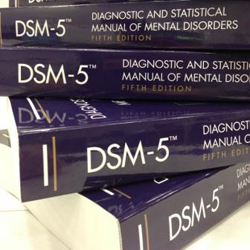The New Enquiry – October 18, 2013
By Sam Kriss
A new dystopian novel in the classic mode takes the form of a dictionary of madness….
It’s also not exactly a conventional novel. Its full title is an unwieldy mouthful: Diagnostic and Statistical Manual of Mental Disorders, Fifth Edition. The author (or authors) writes under the ungainly nom de plume of The American Psychiatric Association – although a list of enjoyably silly pseudonyms is provided inside (including Maritza Rubio-Stipec, Dan Blazer, and the superbly alliterative Susan Swedo). The thing itself is on the cumbersome side. Over two inches thick and with a thousand pages, it’s unlikely to find its way to many beaches. Not that this should deter anyone; within is a brilliantly realized satire, at turns luridly absurd, chillingly perceptive, and profoundly disturbing. If the novel has an overbearing literary influence, it’s undoubtedly Jorge Luis Borges. The American Psychiatric Association takes his technique of lifting quotes from or writing faux-serious reviews for entirely imagined books and pushes it to the limit: Here, we have an entire book, something that purports to be a kind of encyclopedia of madness, a Library of Babel for the mind, containing everything that can possibly be wrong with a human being. Perhaps as an attempt to ward off the uncommitted reader, the novel begins with a lengthy account of the system of classifications used – one with an obvious debt to the Borgesian Celestial Emporium of Benevolent Knowledge, in which animals are exhaustively classified according to such sets as “those belonging to the Emperor,” “those that, at a distance, resemble flies,” and “those that are included in this classification.”
Just as Borges’s system groups animals by seemingly aleatory characteristics entirely divorced from their actual biological attributes, DSM-5 arranges its various strains of madness solely in terms of the behaviors exhibited. This is a recurring theme in the novel, while any consideration of the mind itself is entirely absent. In its place we’re given diagnoses such as “frotteurism,” “oppositional defiant disorder,” and “caffeine intoxication disorder.” That said, these classifications aren’t arranged at random; rather, they follow a stately progression comparable to that of Dante’s Divine Comedy, rising from the infernal pit of the body and its weaknesses (intellectual disabilities, motor tics) through our purgatorial interactions with the outside world (tobacco use, erectile dysfunction, kleptomania) and finally arriving in the limpid-blue heavens of our libidinal selves (delirium, personality disorders, sexual fetishism). It’s unusual, and at times frustrating in its postmodern knowingness, but what is being told is first and foremost a story.
This is a story without any of the elements that are traditionally held to constitute a setting or a plot. A few characters make an appearance, but they are nameless, spectral shapes, ones that wander in and out of view as the story progresses, briefly embodying their various illnesses before vanishing as quickly as they came – figures comparable to the cacophony of voices in The Waste Land or the anonymously universal figures of Jose Saramago’s Blindness. A sufferer of major depression and of hyperchondriasis might eventually be revealed to be the same person, but for the most part the boundaries between diagnoses keep the characters apart from one another, and there are only flashes. Read the entire article here: http://thenewinquiry.com/essays/book-of-lamentations/



SHARE YOUR STORY/COMMENT